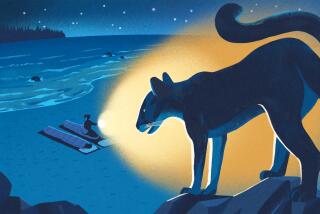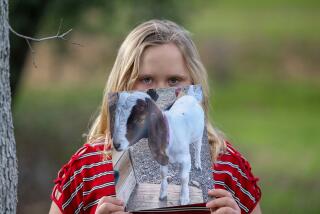Opinion: The lesson of Cecil: Big-game trophy hunting should be outlawed
In the days since Walter Palmer, a Minnesota dentist and big game trophy hunter, was revealed to have killed a beloved and well-known male lion named Cecil outside a protected habitat in Zimbabwe, Cecil has become the face of the slaughtered trophy and Palmer has become the face of the brutal hunter.
This past weekend, Cecilâs face was featured among a group of endangered species projected in lights onto the side of the Empire State Building. The dentist, whom Zimbabwe wants to extradite on charges of illegal hunting, has become so globally reviled that he has gone into hiding. My guess is that if anyone finds him, it will be a tenacious booker from, say, the âToday Showâ or âGood Morning America.â Meanwhile, Zimbabwean officials have suspended hunting of lions, leopards and elephants outside the Hwange National Park. They have also announced that they are seeking a Pittsburgh doctor and hunter who, they say, illegally killed a lion. And on Monday, Delta Airlines announced that it would ban the shipment worldwide of all lion, leopard, elephant, rhinoceros and buffalo trophies as freight.
But while we wait to see what happens here, this tragic incident (and it is tragic) has prompted something remarkable: For the first time on such a wide scale â social media, TV, print â people are grappling with the grim reality of what big game hunting is.
Every lion or black rhino or bear that is hunted purely to be a trophy is a Cecil in some way â it may not be famous to tourists, but it is an animal that functions in the world, sometimes with its mates and its offspring, sometimes not. It is a sentient being, killed for no other reason than its value as an ornamental object to the hunter, as a conquest. Itâs not being killed for food or protection.
I have never heard a rational justification for trophy hunting: âThe animal was a danger to livestock, other animals, people.â Then have game wardens or wildlife officials dispatch the animal. âThe animal population is too large to sustain itself.â Again--have wildlife officials cull a herd. (And my favorite:) âFunds raised from auctioning off a hunt help fund wildlife protection efforts.â Really? How about auctioning off an up-close photo safari? How about fundraising without sacrificing a member of the species youâre trying to raise money to save?
This morning, I heard a hunter interviewed on a talk show say that people wrongly believe that hunters donât respect the animals they hunt. Oh, I think hunters respect the power, the speed, the exoticism of the animals they choose to take down. What they donât respect is their right to live.
Hunting restrictions are usually tied to populations of animals. African elephants are endangered â and killed illegally for their ivory. So there are all sort of restrictions on killing elephants. But lions are not endangered so they can be killed.
By that logic, theoretically, what was the big deal about taking Cecil? There are plenty more lions. The fact that Cecil had a specific identity â to humans â made his killing more ghastly. But it shouldnât have. We should value all animals and decide that their lives should not be taken purely for fun. And that is what trophy hunting is. Itâs about killing to get a trophy.
Increasingly, people are more sensitive to protecting animals and deciding that enjoying these exotic creatures involves observing them, perhaps photographing them, but not about ending their existence so we can pose with a picture of a dead animal or hoist its head about a mantle.
I think trophy hunting should be outlawed the world over. But in the meantime, there is a proposed U.S. law that could be put into place that would recognize the fact that the population of lions is declining. Four years ago, a group of animal welfare organizations â including the Humane Society, the International Fund for Animal Welfare, and the Born Free Foundation â petitioned the U.S. Fish and Wildlife Service to classify lions as endangered. Those groups argued that the lionsâ territorial range had been severely decimated by human encroachment and that their population numbers had declined 48% from 1980 when there were an estimated 75,800 to 2002 when there were no more than 39,000. The lion today only occupies 22% of its historical range.
The Fish and Wildlife Service decided late last year to propose listing the lion as threatened â a lesser category than âendangeredâ but a category that will put restrictions on the importation of lion parts (those trophies) from other countries. According to the animal welfare groupsâ petition, of the 7,090 lion specimens (amounting to at least 5,600 lions) traded internationally between 1999 and 2008, more than half went to the U.S. At the very least, listing the African lion as threatened will put some much needed restrictions on hunting them.
Follow the Opinion section on Twitter @latimesopinion
More to Read
A cure for the common opinion
Get thought-provoking perspectives with our weekly newsletter.
You may occasionally receive promotional content from the Los Angeles Times.











